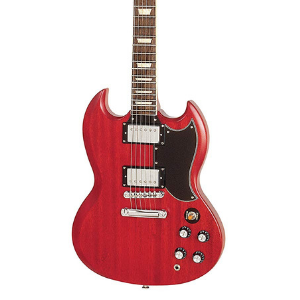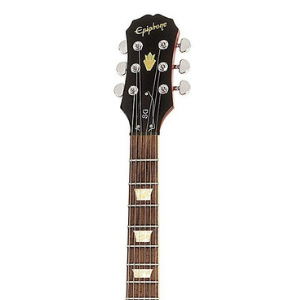- Home
- Instruments
- Gear
- Recording
- Lessons
- Reviews
- Blog


| Body And Neck: |  |
| Electronics: |  |
| Hardware: |  |
| Sound: |  |
| Value: |  |
Epiphone's version of the SG, the SG G-400, offers the same legendary styling and sound at a budget price point that's attainable for players at all levels. Whether you're looking for your first electric guitar or want a change-of-pace model that you can throw around without fear, the G-400 makes a lot of sense.
However, there's a lot of competition in the sub-$500 guitar market To determine whether or not the G-400 stacks up to the other models, let's take a closer look at the details.
 Body and Neck
Body and NeckBased on vintage SG models of the 1960s, the G-400 borrows the SG's iconic double-horned body. It's finished in either cherry or ebony for a swaggering hard-rock look. Like the SG, the G-400 also utilizes a mahogany body; while Epiphone uses more pieces of wood and Gibson takes many of the choice cuts, the mahogany keeps the tonal palette of the G-400 incredibly close to that of its big brother.
The neck is mahogany as well, with a glued-in heel joint at the 19th fret. The glued neck sets this guitar apart from other models in its price range, which most often use bolt-on necks. A 22-fret rosewood fretboard tops that neck, shaped with Epiphone's SlimTaper “D” shape and tailored for a 1.68″ nut width.
It's definitely more substantial than Fender-style necks, but it's manageable for players of most hand sizes. The 12″ radius is also more flat than Fender necks, which makes it easier to play power chords and nail sweeping bends.

Outfitted with a pair of humbuckers, the G-400 uses Epiphone's Alnico Classic design for the neck pickup and an Alnico Classic Plus in the bridge. These are exceptionally high-output humbuckers that can handle even the heaviest distortion you could run them through. They offer plenty of fire to nail overdriven blues, hard rock, and metal tones.
The PRO version of the G-400 also offers coil-tapping for the pickups. By pulling out the knobs, you can convert each humbucker to sound like a single-coil pickup. If you're interested in a G-400 but still want to access some Stratocaster or Telecaster tones, consider purchasing a G-400 PRO.
Beyond the pickups, the G-400 mirrors the SG's dial layout. Each pickup corresponds to a pair of individual tone and volume knobs to give you complete control over your sound. The three-way pickup selector switch alternates between the pickups — the neck is labeled “rhythm,” while the bridge is tagged “lead,” and the middle position on the switch combines the two.
The G-400 uses Epiphone's LockTone Tune-O-Matic bridge and a stopbar tailpiece. The Tune-O-Matic allows you to adjust the intonation of each string individually via the six built-in saddles.
On the headstock, you'll find six Grover tuners with a 14:1 gear ratio. They work great for keeping your guitar in tune and are precise enough to make fine adjustments to your tuning.
For a guitar that costs about 1/4th of a Gibson SG, the Epiphone G-400 offers an outstanding imitation of the SG's sound. With distortion applied, the G-400 has all of the aggressive, hard-edged growl, and screaming high-end that made the SG so popular. If you're interested in this guitar to play classics like AC/DC, Black Sabbath, and even Cream, you won't be disappointed.
It's not perfect — there's less depth to these tones than you'll find in a Gibson, and at points the G-400 sounds a bit shrill or tinny. The clean tones are decent but nothing to write home about, though the coil-tapping feature found on the G-400 PRO version gives you some welcome versatility.
Overall, the Epiphone SG G-400 gives a convincing rendition of the SG's sound and style at a much more affordable price. For the sub-$500 price, Epiphone have managed to preserve a lot of high-quality touches in this instrument, like the set neck and Grover tuners. If you're a distortion-oriented player and you want to look and sound like your idols, the G-400 is a great choice.
For more info about the Epiphone SG G-400, click here.

Reader Interactions